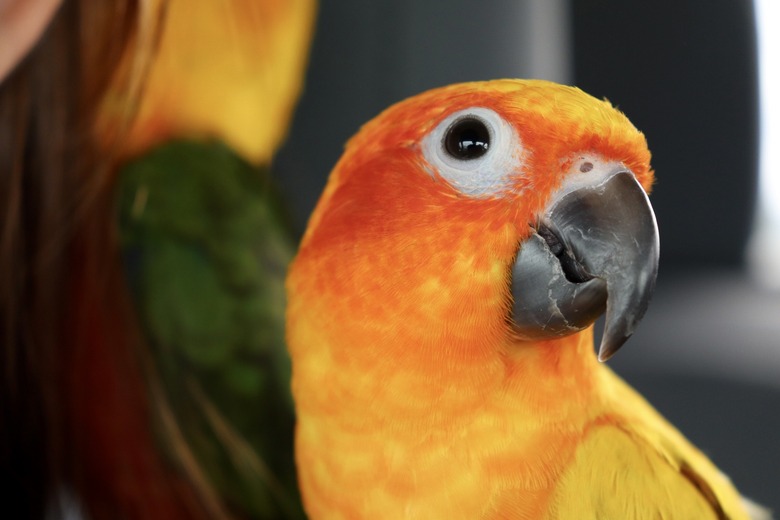How To Tell The Age Of A Sun Conure
Although endangered in their wild South American habitat, sun conures are common parrots in the pet trade. They have brilliant feathers of yellow, orange, green, and blue as adults, but when you buy them as a juvenile at the pet store, they're typically a drab green. Sun conures may live up to 35 years and sometimes wear a leg band that could help you determine the sun conure age.
Sun conures have a band
Sun conures have a band
Sun conures are listed on appendix II of the Convention on International Trade in Endangered Species of Wild Fauna and Flora. This means that the trade of this endangered species is monitored to make sure that demand for the bird does not drive the species to extinction. As a result, it's important for sun conures to have bands to provide positive identification of their legal status.
Importation of endangered birds stopped in 1992, so birds wearing a USDA band are on the older end of their life span. Besides having the letters USDA engraved into the crimped band, an importation band might have three letters and three numbers on the metal band. These open bands were placed on the birds when they were imported, with the ends being crimped together. They do not reflect the bird's actual age, only that they came into the country legally prior to 1992.
Sun conures bred as pets usually also wear a metal leg band. Breeders slip a hatchling's foot through a solid band that might bear the digits of the year the bird hatched in its nest. You should never remove a leg band from a sun conure. If it is causing swelling or other problems, take your bird to the vet for removal and to get your bird another form of identification, such as a tattoo or microchip.
Sun conure color transformation
Sun conure color transformation
Juvenile sun conures start their life wearing shades of drab olive green. In their wild rain forest environment, this helps camouflage the young among the trees. At about 4 to 7 months old, sun conure juveniles begin their first molt and begin to take on more colors.
As they reach their first birthday, the bird has yellow and orange coloration on the head and back with blue feathers on the wing tips. The olive green wings usually remain until the bird is fully sexually mature at 2 years old.
Sun conure growth stages
Sun conure growth stages
A sun conure growth chart can help you know how big your sun conure will be at various stages of his life. Sun conures are just one of many conure types. Baby conures are born completely naked with closed eyes and a black beak. They grow rapidly, sprouting pin feathers and scraggly down on their back by the fourth day of life. Their eyes open during this time, but they don't move around the nest much.
By 10 days old, they are stronger and are able to walk around. Feathers begin emerging on their head, making them look less naked and helpless. By day 18, you'll start to see the sun conure's green coloration as the pinfeathers mature and unfold. Feathers on the head can take on shades of orange or yellow. By 1 month old, most of their fluffy white down has been replaced with green feathers.
By the time they're 6 weeks old, babies are trying their wings and can fly short distances. In the wild, babies fledge at about 8 weeks old, and it's at this age that babies are ready to go to a new home or a cage of their own. Once fully mature at 2 years old, the birds are indistinguishable as to their age for the rest of their life, although they may become mellow and less active in their later years.
